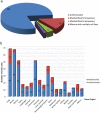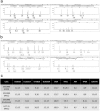A Combination of Species Identification and STR Profiling Identifies Cross-contaminated Cells from 482 Human Tumor Cell Lines
- PMID: 28851942
- PMCID: PMC5575032
- DOI: 10.1038/s41598-017-09660-w
A Combination of Species Identification and STR Profiling Identifies Cross-contaminated Cells from 482 Human Tumor Cell Lines
Abstract
Human tumor cell lines are extremely important tools for cancer research, but a significant percentage is cross-contaminated with other cells. Short tandem repeat (STR) profiling is the prevailing standard for authenticating cell lines that originate from human tissues. Based on the analysis of 482 different human tumor cell lines used in China by STR, up to 96 cell lines were misidentified. More importantly, the study has found that STR profiling alone is insufficient to exclude inter-species cross-contamination of human cell lines. Among the 386 cell lines which had a correct STR profile, 3 of them were inter-species cross-contaminated. Careful microscopic examination may be helpful in some cases to detect changes in morphology but additional testing is needed. Additionally, species verification by PCR could easily identify the contaminants, even with a low percentage of contaminating cells. Combining STR profiling with species identification by PCR, more than 20.5% (99/482) of tumor cell lines were revealed as having been incorrectly identified, including intra-species (14.5%), inter-species (4.4%) cross-contamination and contaminating cell lines (1.7%). Therefore, quality control of cell lines is a systemic issue. Each cell line should undergo a full QA (Quality Assurance) assessment before it is used for research.
Conflict of interest statement
The authors declare that they have no competing interests.
Figures







Similar articles
-
Essential role for gene profiling analysis in the authentication of human cell lines.Hum Cell. 2006 Feb;19(1):43-8. doi: 10.1111/j.1749-0774.2005.00007.x. Hum Cell. 2006. PMID: 16643607
-
Polymerase chain reaction-based species verification and microsatellite analysis for canine cell line validation.J Vet Diagn Invest. 2011 Jul;23(4):780-5. doi: 10.1177/1040638711408064. Epub 2011 Jun 13. J Vet Diagn Invest. 2011. PMID: 21908323
-
Detection algorithm for the validation of human cell lines.Int J Cancer. 2012 Sep 15;131(6):E1024-30. doi: 10.1002/ijc.27533. Epub 2012 Apr 12. Int J Cancer. 2012. PMID: 22419365 Free PMC article.
-
Short tandem repeat profiling: part of an overall strategy for reducing the frequency of cell misidentification.In Vitro Cell Dev Biol Anim. 2010 Dec;46(10):811-9. doi: 10.1007/s11626-010-9352-9. Epub 2010 Oct 7. In Vitro Cell Dev Biol Anim. 2010. PMID: 20927602 Free PMC article. Review.
-
Check your cultures! A list of cross-contaminated or misidentified cell lines.Int J Cancer. 2010 Jul 1;127(1):1-8. doi: 10.1002/ijc.25242. Int J Cancer. 2010. PMID: 20143388 Review.
Cited by
-
P2Y receptors for extracellular nucleotides: Contributions to cancer progression and therapeutic implications.Biochem Pharmacol. 2021 May;187:114406. doi: 10.1016/j.bcp.2021.114406. Epub 2021 Jan 4. Biochem Pharmacol. 2021. PMID: 33412103 Free PMC article. Review.
-
Retraction: Antitumor Activity of Di-n-Butyl-(2,6-Difluorobenzohydroxamato)Tin(IV) against Human Gastric Carcinoma SGC-7901 Cells via G2/M Cell Cycle Arrest and Cell Apoptosis.PLoS One. 2024 Oct 10;19(10):e0312145. doi: 10.1371/journal.pone.0312145. eCollection 2024. PLoS One. 2024. PMID: 39388441 Free PMC article. No abstract available.
-
Cell line authentication using optical genome mapping.BMC Genomics. 2025 Jul 14;26(1):666. doi: 10.1186/s12864-025-11799-0. BMC Genomics. 2025. PMID: 40660122 Free PMC article.
-
Circular RNAs in Epithelial Ovarian Cancer: From Biomarkers to Therapeutic Targets.Cancers (Basel). 2022 Nov 21;14(22):5711. doi: 10.3390/cancers14225711. Cancers (Basel). 2022. PMID: 36428803 Free PMC article. Review.
-
Establishment and characteristics of GWH04, a new primary human glioblastoma cell line.Int J Oncol. 2022 Nov;61(5):139. doi: 10.3892/ijo.2022.5429. Epub 2022 Sep 28. Int J Oncol. 2022. PMID: 36169178 Free PMC article.
References
-
- ASN‑0002, A. T. C. C. S. D. O. W. Cell line misidentification: the beginning of the end. Nat Rev Cancer10, 441–448 (2010). - PubMed
Publication types
MeSH terms
LinkOut - more resources
Full Text Sources
Other Literature Sources
Research Materials

